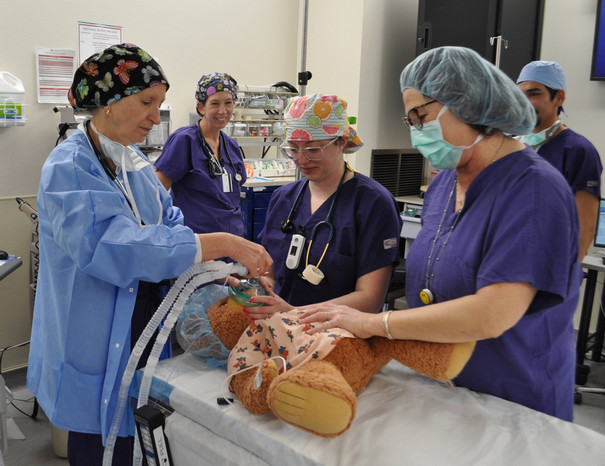Become an anesthesiology resident and have the opportunity to work with children. Apply today.

Welcome to the division of Pediatric Anesthesia at The University of New Mexico School of Medicine. Our team provides perioperative and procedure-related anesthesia services for children, while training future anesthesiologists and pursing ground-breaking research.
UNM is home to UNM Children's Hospital, the only full-service children's hospital in the state, and UNM Carrie Tingley Hospital, the state's only pediatric rehabilitation center. Our clinicians, residents and fellows care for children from New Mexico and throughout the Southwest. UNM Health System provides approximately 4,500 pediatric anesthetics each year.
The division is comprised of pediatric anesthesiologists with training in different parts of the country. Each anesthesiologist has one or more specific areas of interest. We provide anesthesia support for a wide range of surgical procedures in:
Our team also oversees the Children’s Hospital pediatric sedation service and works to continually develop the pediatric regional anesthesia experience. Members of the division participate in several national quality-of-care initiatives, including the PEDI-C Pediatric Difficult Intubation Collaborative and the Pediatric Craniofacial Surgery Collaborative Group.
We also participate in Pediatric Anesthesia COVID Collaboration (PEACOC) a newly formed registry aimed at assessing the impact of COVID-19 on the practice of anesthesiology. Our members have also joined the registry Pediatric AirWay complicationS COVID-19 (PAWS) which is a subgroup of the difficult intubation registry examining difficult airways in patients who have a positive diagnosis of COVID-19.
Residents have ample opportunities to direct pediatric perioperative quality improvement projects. Ultrasound-guided regional anesthesia and central neuraxial techniques are an important element of our program.
The department offers students a four-year nationally accredited anesthesiology residency training program. The robust pediatric surgical caseload and exceptional faculty deliver an outstanding CA2 rotation experience, with an option to participate in a three month long pediatric specific mini rotation as a CA3. As a resident, you’ll provide regional anesthesia care for pediatric patients from newborns to teens.
The residency experience includes pediatric anesthesia specific didactic material during the CA2 pediatric rotation, as well as participation in weekly didactic sessions in the Resident Lecture Series.
The pediatric anesthesiology program offers real-time instruction of “outside learners” in airway and vascular access management. These individuals include:
These collaborations assure ready access to patients, families and clinicians for perioperative, point-of-service care.
Research is a priority in the department of anesthesiology and critical care medicine. Activities in the pediatric anesthesia division are robust and provide learning opportunities for residents. We are currently studying:
Residents have ample opportunities to direct pediatric perioperative quality improvement projects. Ultrasound-guided regional anesthesia and central neuraxial techniques are an important element of our program.
The department offers students a four-year nationally accredited anesthesiology residency training program. The robust pediatric surgical caseload and exceptional faculty deliver an outstanding CA2 rotation experience, with an option to participate in a three month long pediatric specific mini rotation as a CA3. As a resident, you’ll provide regional anesthesia care for pediatric patients from newborns to teens.
The residency experience includes pediatric anesthesia specific didactic material during the CA2 pediatric rotation, as well as participation in weekly didactic sessions in the Resident Lecture Series.
The pediatric anesthesiology program offers real-time instruction of “outside learners” in airway and vascular access management. These individuals include:
These collaborations assure ready access to patients, families and clinicians for perioperative, point-of-service care.
Research is a priority in the department of anesthesiology and critical care medicine. Activities in the pediatric anesthesia division are robust and provide learning opportunities for residents. We are currently studying: